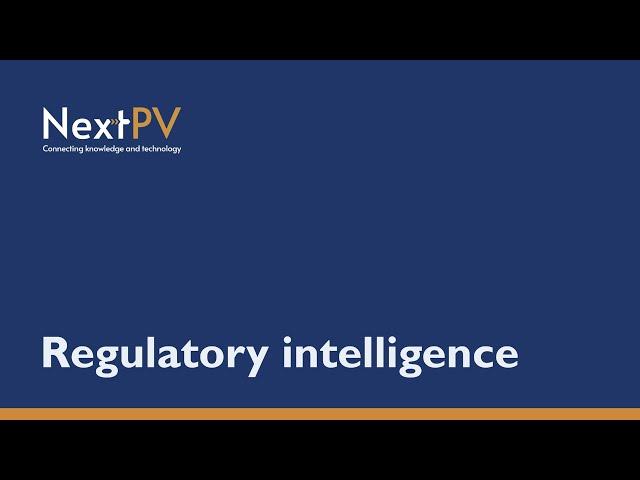
Regulatory Intelligence
🔎 Introduction to Regulatory Intelligence in Pharmacovigilance
Regulatory intelligence in pharmacovigilance is essential for staying updated with the evolving regulatory landscape and ensuring compliance with local and global drug safety regulations. It involves the systematic collection, analysis, and dissemination of regulatory information to support strategic decision-making and effective pharmacovigilance practices.
Key Aspects of Regulatory Intelligence in Pharmacovigilance
🔎 Definition and Objectives:
Regulatory intelligence is the process of gathering, analyzing, and interpreting regulatory information from various sources to inform and guide pharmacovigilance activities. The primary objective is to ensure compliance with current regulations, anticipate changes in regulatory requirements, and align pharmacovigilance strategies with regulatory expectations.
🔎 Core Components:
Information Gathering: Systematic collection of regulatory updates, guidelines, and requirements from local, regional, and global regulatory authorities.
Analysis and Interpretation: Evaluating the impact of regulatory changes on pharmacovigilance activities and the overall drug safety profile.
Strategic Planning: Integrating regulatory insights into pharmacovigilance strategies and operational plans to ensure compliance and proactive risk management.
Communication and Dissemination: Sharing relevant regulatory information with internal stakeholders to ensure alignment and informed decision-making.
🔎 Processes and Procedures:
The process of regulatory intelligence involves several key steps, including:
Monitoring Regulatory Sources: Continuously monitoring websites, publications, and communications from regulatory authorities such as the FDA, EMA, WHO, and local regulatory bodies.
Data Collection and Management: Gathering regulatory information and maintaining an organized database for easy access and retrieval.
Impact Assessment: Analyzing the potential impact of regulatory changes on existing pharmacovigilance practices and drug safety profiles.
Action Planning: Developing action plans to address regulatory changes, including updating standard operating procedures (SOPs), training staff, and adjusting safety monitoring activities.
Stakeholder Communication: Regularly updating internal teams and stakeholders on relevant regulatory changes and their implications for pharmacovigilance activities.
🔎 Regulatory Requirements:
Regulatory intelligence must ensure compliance with various regulatory guidelines and requirements, such as:
International Guidelines: Adherence to guidelines from international bodies like the International Council for Harmonisation (ICH) and the World Health Organization (WHO).
Local Regulatory Frameworks: Compliance with country-specific regulations and guidelines issued by local regulatory authorities.
Global Regulatory Trends: Keeping abreast of global regulatory trends and best practices to maintain a proactive and compliant pharmacovigilance system.
🔎 Audits and Inspections:
Regular audits and inspections of the regulatory intelligence process are essential to ensure the accuracy and timeliness of the information collected and to verify compliance with regulatory requirements. These audits help identify gaps in the regulatory intelligence process and support continuous improvement.
🔎 Documentation and Record Management:
Proper documentation and record-keeping are crucial for regulatory intelligence. This includes maintaining detailed records of regulatory updates, impact assessments, action plans, and communications with regulatory authorities. Accurate documentation supports transparency, regulatory compliance, and effective decision-making.
Implementing robust regulatory intelligence practices ensures that pharmacovigilance activities remain compliant with current regulations, anticipate regulatory changes, and adapt strategies proactively to safeguard patient health and maintain regulatory compliance.
Regulatory intelligence in pharmacovigilance is essential for staying updated with the evolving regulatory landscape and ensuring compliance with local and global drug safety regulations. It involves the systematic collection, analysis, and dissemination of regulatory information to support strategic decision-making and effective pharmacovigilance practices.
Key Aspects of Regulatory Intelligence in Pharmacovigilance
🔎 Definition and Objectives:
Regulatory intelligence is the process of gathering, analyzing, and interpreting regulatory information from various sources to inform and guide pharmacovigilance activities. The primary objective is to ensure compliance with current regulations, anticipate changes in regulatory requirements, and align pharmacovigilance strategies with regulatory expectations.
🔎 Core Components:
Information Gathering: Systematic collection of regulatory updates, guidelines, and requirements from local, regional, and global regulatory authorities.
Analysis and Interpretation: Evaluating the impact of regulatory changes on pharmacovigilance activities and the overall drug safety profile.
Strategic Planning: Integrating regulatory insights into pharmacovigilance strategies and operational plans to ensure compliance and proactive risk management.
Communication and Dissemination: Sharing relevant regulatory information with internal stakeholders to ensure alignment and informed decision-making.
🔎 Processes and Procedures:
The process of regulatory intelligence involves several key steps, including:
Monitoring Regulatory Sources: Continuously monitoring websites, publications, and communications from regulatory authorities such as the FDA, EMA, WHO, and local regulatory bodies.
Data Collection and Management: Gathering regulatory information and maintaining an organized database for easy access and retrieval.
Impact Assessment: Analyzing the potential impact of regulatory changes on existing pharmacovigilance practices and drug safety profiles.
Action Planning: Developing action plans to address regulatory changes, including updating standard operating procedures (SOPs), training staff, and adjusting safety monitoring activities.
Stakeholder Communication: Regularly updating internal teams and stakeholders on relevant regulatory changes and their implications for pharmacovigilance activities.
🔎 Regulatory Requirements:
Regulatory intelligence must ensure compliance with various regulatory guidelines and requirements, such as:
International Guidelines: Adherence to guidelines from international bodies like the International Council for Harmonisation (ICH) and the World Health Organization (WHO).
Local Regulatory Frameworks: Compliance with country-specific regulations and guidelines issued by local regulatory authorities.
Global Regulatory Trends: Keeping abreast of global regulatory trends and best practices to maintain a proactive and compliant pharmacovigilance system.
🔎 Audits and Inspections:
Regular audits and inspections of the regulatory intelligence process are essential to ensure the accuracy and timeliness of the information collected and to verify compliance with regulatory requirements. These audits help identify gaps in the regulatory intelligence process and support continuous improvement.
🔎 Documentation and Record Management:
Proper documentation and record-keeping are crucial for regulatory intelligence. This includes maintaining detailed records of regulatory updates, impact assessments, action plans, and communications with regulatory authorities. Accurate documentation supports transparency, regulatory compliance, and effective decision-making.
Implementing robust regulatory intelligence practices ensures that pharmacovigilance activities remain compliant with current regulations, anticipate regulatory changes, and adapt strategies proactively to safeguard patient health and maintain regulatory compliance.
Комментарии:
Regulatory Intelligence
NextPV
First to 100 Points Wins!
YoBoy PIZZA
Your First Music Composition Lesson - For Beginners
Piano Lessons On The Web
Как цветут мои пеларгонии в 1 литровых горшках по чему они там оказались?!
Любимые пеларгонии
Dan Schumacher retiring this spring
WQOW News 18
로봇 호텔 | 인전교육 | 경찰 | 래브라도 경장 동화
래브라도 경장 - 동화
全球生活成本最贵城市!香港¥7000一晚酒店,吃什么?
觅食Meetfood
فتحت مقايضات الحدث تجربه خطه هجوميه FC Mobile 24
هادي البابا_Hady ElBaba
Minister Ponnam Prabhakar Press Meet Live | V6 News
V6 News Telugu


























